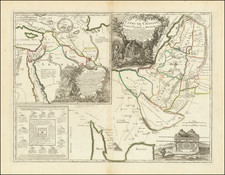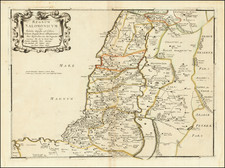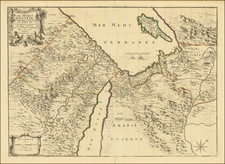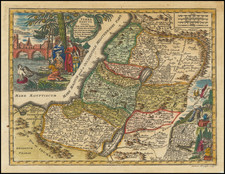Mapping the Holy Land: A 17th Century Representation of the Twelve Tribes of Israel and Historical Battles
This map of the Holy Land from the 17th Century is a significant piece of cartographic artistry that encapsulates the historical territories of the 12 tribes of Israel. As is typical of the East-oriented maps of that era, it places East at the top, providing a different perspective for modern viewers. Herein, we detail the prominent features and the accompanying biblical accounts associated with each.
- The 12 Tribes of Israel: These tribes trace their descent from the twelve sons of Jacob. The territories for each tribe were: Judah, Benjamin, Ephraim, Manasseh, Reuben, Simeon, Levi, Issachar, Zebulun, Dan, Asher, and Naphtali. Their regions of settlement are integral to the religious and cultural heritage of the Jewish people.
- The Dead Sea with Four Fires: The fires named Adama, Seboun, Sodom, and Gomorra depict the biblically infamous cities of sin. As described in Genesis 19, God destroyed Sodom and Gomorrah due to their wickedness, with fire and brimstone.
Biblical Battle and Other Scenes Depicted:
- Overthrow of Og by Moses: Moses led the Israelites to a victory against King Og of Bashan, as recorded in Numbers 21:33-35.
- Overthrow of the Damascenes by Baldwin and Baldwin II: While not directly biblical, these events refer to the Crusades' era, where Baldwin and his successor reclaimed territories from the Muslims in the Holy Land.
- Overthrow of Jabin, King of Hazor, by Joshua: Joshua and the Israelites defeated King Jabin and the city of Hazor, as detailed in Joshua 11.
- Overthrow of Jahin: While this event isn’t specifically mentioned in the Bible, it may refer to a misinterpretation or a variation in names used in different texts.
- Gideon's Overthrow of the Midianites in the Valley of Jezreel: Gideon, with only 300 men, miraculously defeated the vast Midianite army, as described in Judges 7.
- Battles in the Valley: This valley has witnessed several clashes: Saul vs. the Philistines (1 Samuel 31), Ahab vs. the Syrians (1 Kings 20), and the Tartarians against the Saracens, which refers to the Mongol invasions and their battles against the Muslim Saracens.
- Overthrow of Josiah by Pharaoh: King Josiah of Judah was killed at Megiddo by Pharaoh Necho II, as recorded in 2 Kings 23:29.
- Overthrow of Nicanor by Judas Maccabeus: A significant event during the Maccabean revolt, Judas Maccabeus defeated Nicanor, ensuring Jewish autonomy, as described in the Book of Maccabees.
- Overthrow of Zebah and Zalmunna by Gideon: After defeating the Midianites, Gideon pursued their kings, Zebah and Zalmunna, and executed them (Judges 8:21).
- Sihon Overthrown by Moses: Before entering Canaan, the Israelites, under Moses' leadership, defeated King Sihon of the Amorites (Numbers 21:21-31).
- Joshua's Passage Over the Jordan: In Joshua 3, the Israelites miraculously crossed the Jordan River, with its waters held back by God’s power.
- Valley of Blessing: 2 Chronicles 20 details how the Moabites, Ammonites, and some of the Meunites invaded Jehoshaphat's kingdom. However, they turned on each other, resulting in their mutual destruction.
- Great Battle between Zerah of Arabia and Asa of Judah: 2 Chronicles 14 tells of Asa's victory against the vast army led by Zerah the Ethiopian.
This 17th-century map acts as a mosaic of biblical narratives, historic battles, and the geographical expanse of ancient Israel. Through this, viewers can journey through time, tracing the footsteps of patriarchs, prophets, and kings against the backdrop of the Holy Land.









![De Gelegentheyt van't Paradys en't Landt Canaan mitsgaders d'eerst bewoonde Landen der Patriachen uyt de H. Schristure …[Shows Cyprus]](https://storage.googleapis.com/raremaps/img/small/82746.jpg)




![[Tribe of Zebulon] Zebulon ad Portum Marium Ipse ad Portu Marium Habitabit](https://storage.googleapis.com/raremaps/img/small/85057.jpg)